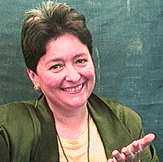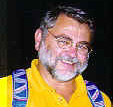
David M. Merrill
Professor, Instructional Technology
Director, ID2 Research Group.
Utah State University
EMAIL -
HOME PAGE
Field/Interests
Authoring & instructional design expert systems; Component Display Theory
for instructional strategies, Elaboration Theory for content sequence,
Instructional Transaction Theory.
| David Merrill's Top Ten List
(Date Submitted: December 10, 1999 )
In keeping with David Letterman's approach I have listed my top 10 in reverse order. I have limited my top 10 to books related to instructional design rather than to the entire field of instructional technology. There are other equally important books in other areas that I have not included here.
M. David Merrill
10. Merrill, M. David, Tennyson, Robert D. & Possey, Larry O. Teaching Concepts: An Instructional Design Guide 2nd Ed. Educational Technology, 1992.
This book is perhaps the best written of my work. After 30 years of advocating effective concept teaching this most important of instructional goals is still not taught very well. All who have used this recipe book have found that the prescriptions really work and that their concept instruction is indeed more effective.
9. Merrill, M. David with David G. Twitchell (Ed.) Instructional Design Theory. Educational Technology, 1993.
A collection of my most important papers over a 20-year period from the early 1970's through the 1980's. Most important, Component Display Theory (CDT) has had a major impact on instructional design practice. This book brings together and integrates the several chapters on CDT and adds important new information and research findings. This is the most complete presentation of CDT available.
8. Reigeluth, C. (1983). Instructional design: Theories and models. Hillsdale, NJ: Erlbaum Assoc.
A classic when it was published and still current. This very important work brought together the best known instructional theories of the 70's. Instructional design based on these theories is more effective and efficient than instructional design based on experience and common sense. These theories form the foundation of much that is currently being said about instructional design.
7. Reigeluth, Charles M. (Ed.) Instructional-Design Theories and Models: A New Paradigm of Instructional Theory. Vol. II. Lawrence Erlbaum Associates. 1999.
A collection of theories representing the considerable diversity available today for directing the design of instruction. Reigeluth tags these many approaches as a "new paradigm". They do in fact represent the current push on a more constructivist approach to instructional design. There is considerable emphasis on learner-centered, experience-based instruction. A very important source for instructional designers to enable you to become familiar with the current trends in instructional design, especially in the United States.
6. Tennyson, Robert D., Schot, Franz, Norbert, Seel & Dijkstra, Sanne. Instructional Design International Perspective Vol. 1 Theory, Research, and Models. Lawrence Erlbaum Associates, 1997.
We have a tendency in the USA to be very myopic in our view. We too often forget that we have very bright and important colleagues across the sea. Tennyson, with some European colleagues, has provide an extremely important collection of both European and USA theorists. Some of the chapters in this volume are classics and should be must reading for all instructional designers.
5. Gagne, Robert M. The Conditions of Learning and Theory of Instruction. 4th Ed. Holt, Rinehart & Winston, 1985.
I have always felt that the most important single source for instructional designers is Gagne's "Conditions of Learning". If you haven't read this book, you should. It lays the foundation for much of what we do in instructional design. While there are many interesting ideas and theories put forth especially during the past 10 years, Gagne still provides the most solid foundation for a science of instruction and a technology of instructional design. It was important because he founded his recommendations for instructional design in Information Processing Learning Theory and derived his prescriptions from this theory base.
4. Van Merrienboer, Jeroen J. G. Training Complex Cognitive Skills: A Four-Component Instructional Design Model for Technical Training. Educational Technology, 1997.
In my opinion this book now ranks with Gagne as a fundamental foundation for instructional design. Whereas Gagne is based on the best theory available during the 60's, 70's and 80's van Merrienboer is based on the new theory in cognitive psychology available during the late 80's and 90's. This book should be must reading for all instructional designers.
This book it is the best integration of much of the current work in instructional design that is available. van Merrienboer's model integrates the best of both the instructivist and constructivist approachs to learning. He shows how these two ways of viewing instruction are both valuable and necessary to effective instructional design. He incorporates the best suggestions from the best of the instructional models that are summarized in other books such as Reigeluth's "Instructional Design Theories and Models, Vol. 2" and Tennyson, et al's "Instructional Design: International Perspective". He starts by summarizing important theory from cognitive psychology research and then relates the two aspects of instructional design, analysis and design, to this cognitive theory. Many of the prescriptions he suggests are supported by solid research that he cites. Finally, it is one of the best examples of technical writing that I have experienced. The content is complex but extremely easy to read. The organization of the book is tight, his summaries are concise and very helpful, he includes a list of all the important concepts introduced in each section, and he includes suggested readings (not just references) for each section of the book.
3. Norman, Donald A. The Design of Everyday Things. Doubleday & Company. 1990.
At the top of my list I have moved away from books that were written specifically for instructional designers. The top 3 books on my list have influenced my thinking in direct and indirect ways and as a result have made me a better instructional designer. Norman's classic work will change forever how you view the world. It has implications for all aspects of design including and especially instructional design.
2. McCarthy, Bernice About Learning. Excel, Inc. 1996.
McCarthy is for me a recent discovery. I have always dismissed learning styles as folk science and hence have not paid a great deal of attention to this work. However, after I heard McCarthy make a very persuasive presentation I purchased her book and my life has not been the same since. But be prepared. This book is not a scientific treatise complete with footnotes and references, it is rather scientific poetry. And like all good poetry it penetrates not just the intellect but also the sole. And after careful reflection it has affected every aspect of how I think about instructional design. Perhaps you will also find inspiration in her work.
1. Hofstadter, Douglas R. Godel, Escher, Bach: An Eternal Golden Braid. Vintage Books, 1979, 1989, 1999.
Hofstadter is about the world and how we look at it. It is my favorite book. Reading this book is an experience to be savored and enjoyed. Great discoveries are seeing how diverse ideas relate. Hofstadter changed the way I look at the world. As a result I find inspiration for instructional design from areas that I would have never previously considered. Someone said that all truth can eventually be circumscribed into one great whole. Hofstadter certainly makes this a more plausible hypothesis.
|



















